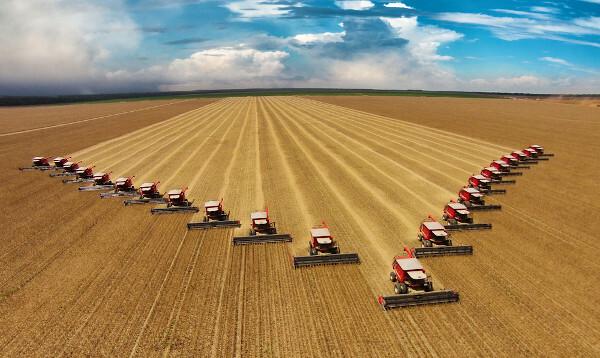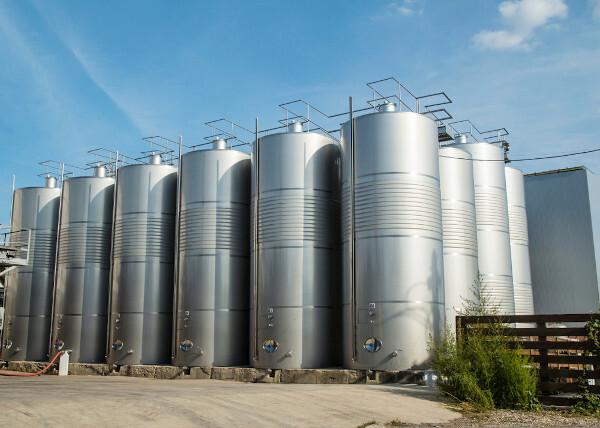O agribusiness this is a very important economic sector for world society, as it involves a food production chain which interconnects various sectors, such as agriculture, livestock and industry, in addition to the commerce that consumes its products.
In this sector, the use of technology is intense, not being restricted to the rural field, but also present in the industrial field, with industries of seeds, fertilizers, pesticides and other agricultural inputs.
Read too: Evolution of agriculture and its techniques

What is agribusiness?
Agribusiness, also known as agribusiness, understand the economic activities related to agriculture, forest management for trade and services (forestry) and plant extraction. This term was coined in the 1950s, but became popular in the 1970s, at the height of the Green Revolution.
All companies that provide agricultural inputs to farmers, medicine for livestock and machinery for agriculture and banks that provide financial loans to large rural entrepreneurs are also related to the agribusiness.
In addition to these segments, we can mention as a member of agribusiness the business, whether retailer or wholesaler, which deals with products aimed at the rural environment. Storage, logistics, distribution and even the marketing of these commercial activities are also grouped in agribusiness. With that, we can see that various sectors of the economy are related to agribusiness, which shows its strength and socioeconomic importance.
Do not stop now... There's more after the advertising ;)
Agribusiness characteristics
As characteristics of agribusiness, we can mention the medium and large rural properties that achieve high productivity in their respective branches of production, both in agriculture and livestock. In agriculture, the practice of monoculture, that is, the production of one type of planting only. In many cases, there are properties that practice both modalities, raising cattle and planting some type of vegetable.
Medium and large rural properties play an important role for another characteristic of agribusiness: a field modernization. This is the result of intense scientific and technological changes from the 1950s onwards, with greater intensity in the 1970s, with the emergence of Genetically Modified Organisms (GMOs), by example.
This modernization encompasses machines, modified seeds, cultivation techniques and animal husbandry and development of products that accelerate the natural planting and growth cycle of plants and cattle. There are specialized laboratories in improving animal species or for crops in order to improve and increase production.
These factors (property extension and modernization) contribute to high productivity of the ground, which means that there is a modernized agriculture. All of this is the result of large capital investments, which is another outstanding feature of agribusiness: the concentration of income and wealth.
See more: Crop rotation – planned crop rotation to conserve soil
Agribusiness sectors
Due to its complexity and the various production chains involved, we can say that agribusiness covers the three sectors of the economy: primary, secondary and tertiary.

O primary It is related to rural production, both agricultural and livestock. O second sector is connected to agribusiness, large farms that plant and process raw materials on an industrial scale, such as large orange-producing farms that already produce bottled juice, ready to be sold/consumed.
Then we come to third sector, that of commerce. THE distribution and sale of rural products move billions around the world, making the activity highly profitable and sophisticated due to the degree of complexity of the three sectors.
agribusiness cycle
The agribusiness cycle can be divided into three stages:
- rural production
- Agribusiness
- Involvement of the trade and logistics sector
The complexity of agribusiness makes it an economic activity that involves practically all stages of the economy. First we have the medium and large rural landowners with its varied activities: raising cattle, planting crops, fruits, vegetable extraction, among others.
Then there is the industry involvement that work in this area with rural machinery (tractors, irrigation equipment, plowing, harvesters) and with fertilizers, fertilizers, pesticides, genetically modified (transgenic) seeds and inputs.
At the end of the production line, but no less important, we have the commercial activities, with the storage, distribution and sale of rural products to final consumers, being these consumers at local, regional, national and/or global scales.
It is noteworthy that, despite being in the agribusiness cycle, the trade sector is not agribusiness, but is part of a large production chain.
Agribusiness in Brazil
Brazil, with its enormous territorial extension (fifth largest country in the world) and all the great amount of natural resources (biomes, hydrography, fertile soils in some locations), is one of the great protagonists of world agribusiness.
According to data from the Brazilian Institute of Geography and Statistics (IBGE), in 2018, our country had the largest cattle herd for slaughter in the world, with 213,523,056 heads of cattle, in addition to more than 245 million chickens (chickens) and 41 million pigs. We are one great power in this matter, feeding one-sixth of the world's population, according to the Ministry of Agriculture.
![Cattle in Mato Grosso do Sul, the state with the third largest cattle herd in the country, behind Minas Gerais (second) and Mato Grosso (first). [1]](/f/ef519dc32e0b5781481db97ec12a057b.jpg)
However, agribusiness in Brazil is not just about livestock. IBGE estimates point to great records for soy, sugarcane and orange crops in the coming years, whose products make the Brazilian territory the leader in the international ranking. The projection for grain production in 2027 is over 355 million tons, an increase of just over 25% compared to the 2018 harvest, which was 232 million tons.

The grains that stand out the most in national production are soy and corn, both with 38 million and 16 million tons produced in 2019, respectively. Most of these productions take place in the Midwest in the country, with emphasis on Mato Grosso, the state with the largest cattle herd in the country, with more than 30 million heads of cattle, and leadership in soybean cultivation.
Advantages and Disadvantages of Agribusiness
One of the great advantages of agribusiness, associated with field modernization, is the increase in the production of food and products from the countryside, such as oils, wines, textiles and even cigarettes, with the planting of tobacco.
In recent decades, the world food production has been increasing considerably, being able, efficiently, to feed the entire world population, however this production does not reach all places.
According to United Nations Children's Fund (Unicef), hunger kills one person every four seconds in the world. According to United Nations (UN), 870 million people are undernourished on the planet, a frightening number considering the large amount of food produced lately.
Agricultural modernization raises productivity, but this has a very expensive environmental cost. You environmental impacts caused by agricultural practices in many regions are practically irreversible:
- logging and burning of preservation areas for the emergence of crops and pastures;
- soil contamination due to excessive use of pesticides and fertilizers, and others.
Among the most dangerous environmental impacts in agribusiness, we can mention the accentuation of erosive processes and the soil degradation. As the soil is a renewable resource, it must be used according to its capacity, which in many rural properties does not happen. In addition, the removal of vegetation cover for the implantation of pastures and crops can accentuate erosion, with significant losses of arable land.
There are also social impacts, such as:
- unemployment and rural exodus, because, with the exaggerated use of machines, the presence of human labor decreases;
- probable diseases arising from food contaminated with pesticides;
- increase in agrarian conflicts over land tenure;
- increased concentration of income and inequality in rural areas.
Also access: What are the main agricultural powers?
solved exercises
Question 1 - (IFMT/2016)
According to the National Supply Company (Conab), MT will offer 51.203 million tons of grain, especially soy and corn, in the 2014/2015 season.
(Newspaper The Gazette. 01/09/2015 p3C)
Agribusiness is the most important sector in the Brazilian economy, with emphasis on the state of Mato Grosso. About this sector in Brazil, it is INCORRECT to state that
A) It involves several sectors, such as precision agriculture, biotechnology with investments and the presence of transnational corporations in the fields of production of food, machinery and agricultural inputs.
B) the productive modernization process aimed at inserting agricultural commodities into the world market has been marking the economy of the Midwest region.
C) among the main export agribusiness products are: soy, meat, forest products, coffee, tobacco and its derivatives, leather, cereals, fruit juice, fibers and textile products.
D) with the advance of biotechnology in the agricultural sector, planning, production, commercialization and commercial exploitation transform the entire sector into agribusiness.
E) the main destinations for Brazilian production in the sector are China, the European Union, Venezuela, Saudi Arabia, Argentina, the United States, Russia and Japan.
Resolution
Alternative D. Not all activities are agribusiness, but they are interconnected. Alternative D treats as if the entire production chain were agribusiness, What is not true.
Question 2 - (UEPA/2015)
Techniques are a set of instrumental and social means, with which man carries out his life, produces and, at the same time, creates space [...]. Regarding the dynamics of production and forms of appropriation of agrarian space in the capitalist logic, it is correct to state that:
A) in agribusiness, polyculture, salaried work and small-scale production are some of the main references, while the peasantry is characterized by biodiversity, monoculture, family work and large-scale production scale.
B) citrus farmers are family producers who predominantly use salaried work; on the other hand, the capitalist citrus growers predominantly use the work of family members, whose number has to be greater than that of salaried workers, except during the harvest period.
C) the peasantry does not promote the concentration of land, work, power; as opposed to the capitalist producer, who, when carrying out his production, goes beyond the limits of time and space, due to the need for this concentration for his expansion.
D) the predominance of family work in agribusiness values the non-capitalist social relationship that determines the use of the territory, as the predominance of family work in the peasantry determines the area of production, working time, income and quantity. produced.
E) the peasantry is part of agribusiness and it is the peasant who controls technology, knowledge, the market and agricultural policies, given that it is autonomous in relation to capital, even when it produces through the agribusiness.
Resolution
Alternative C. The small producer, also known as the peasantry, acts in an antagonistic way to the large producer, as the latter, as we have seen, it promotes large investments in medium and large areas, increasing the concentration of land and, consequently, of income.
Image credit
[1] serginho pirez / Shutterstock
By Attila Matthias
Geography teacher

